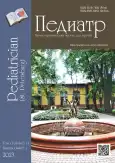Features of the course of pneumonia in children with coronavirus infection
- 作者: Isakova A.Z.1, Kabaeva D.Z.2, Maimerova G.S.2, Musurkulova B.A.1, Bolotbekova A.Z.1, Boryakin Y.V.1
-
隶属关系:
- I.K. Akhunbayev Kyrgyz State Medical Academy
- National Center for Maternal and Child Health
- 期: 卷 14, 编号 1 (2023)
- 页面: 27-33
- 栏目: Original studies
- URL: https://journals.rcsi.science/pediatr/article/view/131595
- DOI: https://doi.org/10.17816/PED14127-33
- ID: 131595
如何引用文章
详细
BACKGROUND: The most frequent complication of coronavirus infection (COVID-19) in young children is severe viral pneumonia.
AIM: To reveal the features of the course of coronavirus pneumonia in children.
MATERIALS AND METHODS: A retrospective analysis of 54 case histories of children with coronavirus pneumonia, aged 1 month to 15 years, who received inpatient treatment in the Department of Pulmonology was performed.
RESULTS: The disease was most often registered in children of the first three years of life (66,7%). 49 (90,7%) children turned out to be from family foci of coronavirus infection. The majority of children (44–81.5%) had signs of respiratory failure of I-II degree. Polymerase chain reaction (PCR) for the presence of coronavirus was positive in 37 (68.5%) children. Radiologically, bilateral infiltrates were detected predominantly in the middle and lower parts of the lungs. The multisystem inflammatory syndrome associated with SARS-CoV-2 was characterized by persistent fever, multiple organ damage and clinical and laboratory shifts.
The vast majority of cases involved transmission from adult patients. The disease most often developed in children under 3 years of age. The course of the disease is accompanied by the development of grade I–II respiratory failure and intoxication. PCR for the presence of coronavirus may be negative due to late admission of patients to the hospital. Radiological changes were characterized by extensive bilateral lesions mainly in the lower and middle lobes of the lungs. Persistent fever, multiorgan lesions, clinical and laboratory shifts in coronavirus pneumonia in children indicate the development of multisystem inflammatory syndrome associated with SARS-CoV-2.
CONCLUSIONS: Pneumonia in most cases proceeded with the development of respiratory failure, symptoms of gastrointestinal tract damage, a pronounced intoxication syndrome. At the same time, there was revealed inconsistency of radiologically extensive lung lesions with more scanty auscultatory data.
作者简介
Albina Isakova
I.K. Akhunbayev Kyrgyz State Medical Academy
编辑信件的主要联系方式.
Email: aisakova93@mail.ru
assistant, Academician D.K. Kudayarov Department of Hospital Pediatrics with a Course of Neonatology
吉尔吉斯斯坦, BishkekDinara Kabaeva
National Center for Maternal and Child Health
Email: dinara_kab@mail.ru
канд. мед. наук, ст. научн. сотр., заведующая отделением пульмонологии
吉尔吉斯斯坦, BishkekGulzat Maimerova
National Center for Maternal and Child Health
Email: sh.gulzat@yandex.com
MD, Dr. Sci. (Med.), senior research associate, director
吉尔吉斯斯坦, BishkekBubalima Musurkulova
I.K. Akhunbayev Kyrgyz State Medical Academy
Email: musurkulova_b@mail.ru
MD, Cand. Sci. (Med.), assistant professor, Academician D.K. Kudayarov Department of Hospital Pediatrics with a course of neonatology
吉尔吉斯斯坦, BishkekAinura Bolotbekova
I.K. Akhunbayev Kyrgyz State Medical Academy
Email: bolotbekova75@mail.ru
MD, Cand. Sci. (Med.), assistant professor, Academician D.K. Kudayarov Department of Hospital Pediatrics with a course of neonatology
吉尔吉斯斯坦, BishkekYuri Boryakin
I.K. Akhunbayev Kyrgyz State Medical Academy
Email: boriakiny@gmail.com
MD, Cand. Sci. Med., assistant professor, Academician D.K. Kudayarov Department of Hospital Pediatrics with a course of neonatology
吉尔吉斯斯坦, Bishkek参考
- Alexandrovich YuS, Alekseeva EI, Bakradze MD, et al. Clinical Features and Management of the Disease Caused by New Coronaviral Infection (COVID-19) in Children. Version 2. Pediatric pharmacology. 2020;17(3):187–212. (In Russ.) doi: 10.15690/pf.v17i3.2123
- www.who.int [Internet]. Vstupitel’noe slovo General’nogo direktora na press brifinge po COVID-19 11 marta 2020 g. [cited 2020 Jun 27]. Available at: https://www.who.int/ru/director-general/speeches/detail/who-director-general-s-opening-remarks-at-the-media-briefing-on-covid-19-11-march-2020 (In Russ.)
- www.who.int [Internet]. Zayavlenie po itogam vtorogo soveshchaniya Komiteta po chrezvychainoi situatsii v sootvetstvii s Mezhdunarodnymi mediko-sanitarnymi pravilami, v svyazi so vspyshkoi zabolevaniya, vyzvannogo novym koronavirusom 2019 g. (nCoV) [cited 2020 Jul 16]. Available at: https://www.who.int/ru/news/item/30-01-2020-statement-on-the-second-meeting-of-the-international-health-regulations-(2005)-emergency-committee-regarding-the-outbreak-of-novel-coronavirus-(2019-ncov) (In Russ.)
- Melekhina EV, Gorelov AV, Muzyka AD. Clinical characteristics of COVID-19 in children of different ages. Literature review as of april 2020. Clinical practice in pediatrics. 2020;15(2):7–20. (In Russ.) doi: 10.20953/1817-7646-2020-2-7-20
- Namazova-Baranova LS. Coronaviral Infection (COVID-19) in Children (Situation on April 2020). Pediatric pharmacology. 2020;17(2):85–94. (In Russ.) doi: 10.15690/pf.v17i2.2094
- Brackel CLH, Lap CR, Buddingh EP, et al. Pediatric long-COVID: AN overlooked phenomenon? Pediatr Pulmonol. 2021;56(8):2495–2502. doi: 10.1002/ppul.25521
- Huang C, Wang Y, Li X, et al. Clinical features of patients infected with 2019 novel coronavirus in Wuhan, China. Lancet. 2020;395(10223):497–506. doi: 10.1016/S0140-6736(20)30183-5
- Hoste L, Van Paemel R, Haerynck F. Multisystem inflammatory syndrome in children related to COVID-19: a systematic review. Eur J Pediatr. 2021;180(7): 2019–2034. doi: 10.1007/s00431-021-03993-5
- Jiang L, Tang K, Levin M, et al. COVID-19 and multisystem inflammatory syndrome in children and adolescents. The Lancet. 2020;20(11):E276–E288. doi: 10.1016/S1473-3099(20)30651-4
- Ludvigsson JF. Systematic review of COVID-19 in children show milder cases and a better prognosis than adults. Acta Paediatr. 2020;109(6):1088–1095. doi: 10.1111/apa.15270
补充文件







